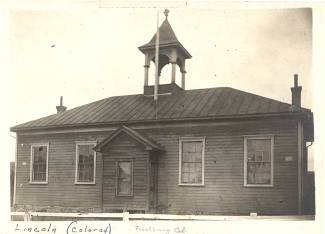Collection Name
About
Lincoln School History Traced
Over the past year or so several inquiries have come to me about the Lincoln School here in Frostburg. To most people, that name is associated with the small brick building that is now the headquarters for the campus police at the university.
There was an earlier schoolhouse by that name on the south side of Park Avenue, where Compton Hall stands today, but until last week, when the picture plainly labeled "Lincoln School” turned up, there was no concrete link between that building and one that supposedly preceded it on Maple Street.
I have never seen a picture of Tamar Brown's school, started in 1867 when she, a freed woman, bought a quarter-acre lot at the intersection of Maple Street and Park Avenue. And, of course, there is no one living who ever knew the lady, though her reputation lives on. She may have taught in the school she built behind her house, although she is described in the census rolls as a laundress.
Public education came to Maryland after the Civil War, and board of education minutes are available from the beginning. The early records, though, frustrate a researcher, telling us, for instance, that there were 88 existing schools in Allegany County in 1867, but giving no information about their location, the teachers who staffed them or what they were taught.
The first mention of a colored school in Frostburg is a notation in 1873 that the building was "uncomfortable.” Later that year the board paid a bill for plastering and a much larger one for unspecified repairs. We can only infer that, like most of the schools of the time, it was a single room fitted out with benches and a desk or two.
At some time before the turn of the century (the board minutes give no clue) Tamar Brown's school was replaced by a larger structure, shown in the picture. Obviously it had two rooms, each with its own pot-bellied stove. It had a cupola - intended for a bell? - but seems to have been unpainted. Like other schools of that time, it would have had outdoor privies and depended on water from a well.
The Lincoln School existed 30 years before the Frostburg Normal School opened, but when the latter became a State Teachers College it needed to expand and the colored school was in the way. In 1935 Mr. Dunkle, the college president, suggested to the board of education that he would swap the land that he had recently bought from the Frostburg Baseball Association for the plot on which the Lincoln School stood. He offered to sweeten the deal by promising to pay $1,750 to move the building and cover the cost of any damage that occurred in transit.
The board of education delayed decision for the better part of a year. Would it be better to build a new school at a price that they estimated at less than $3,000? Could they apply for a government grant, and use WPA labor to cut the cost? Could they save money by placing the structure on a foundation without a basement?
The lowest bid for a new school came in over $5,000, so the board finally settled with a contractor who agreed to move the building for $412 and build the necessary foundation for anther $998.
In the meantime, the children who were enrolled at Lincoln School were attending classes in a store on Broadway. The board minutes do not report how long this arrangement lasted, but I have been told that after Lincoln School was settled in it new location the parents realized that it had none of the amenities - electricity, central heating, or running water - which they had expected. They boycotted the building until the situation had been rectified!
Lincoln School, as I first saw it, had the same shape as is shown in the earlier picture, but it was painted white and I don't remember a cupola. People who were students there tell me that the building held two classrooms, separated by a hallway, and that at times there were two teachers, a lady for the lower grades and a man to keep control of the upper classes.
In later years only one teacher was needed because the bigger children traveled by bus to Carver in Cumberland. The Lincoln School on Park Avenue was razed to make way for Compton Hall. The brick replacement was used only a year or two until the schools were integrated.
But from Tamar Brown's time, just after the Civil War, until 1958 the colored schools in Frostburg provided a solid educational foundation for the pupils and an important chapter in the history of our town.
Betty Van NewKirk, Curator of the Frostburg Museum wrote this article for Frostburg ExPress in the Cumberland Times-News
This photograph depicts the old Lincoln School which once stood, roughly, upon the site of the current Compton Science Center. As noted in the article the school structure was later relocated to University Drive (Beall Street Extended). It was on that site a brick Lincoln School building, now home to the Frostburg State University police, was later constructed in 1955.
Photograph Courtesy of the Allegany County Board of Education.
